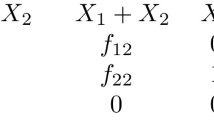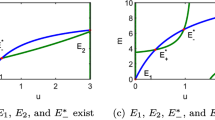Abstract
A basic discrete-time heterogeneous capital goods competitive environment is considered, its potential for displaying steady growth solutions analyzed and the properties of the latter characterized. A first composite good may be used for consumption or investment on a one-to-one basis, while a second good is only used for accumulation, solely capital inputs being part of the production process. This framework is first considered from the allocative standpoint through the derivation of the frontier of the production possibility set. Having defined the perfect foresight competitive equilibrium that also describes a Pareto optimum over time, attention is then given to the potential for unbounded steady growth solutions. Under interiority, summability, and expansivity restrictions, there is a unique optimal steady growth rate. For unitary depreciation rates of both capital goods, locally there exists a unique convergent sequence to this steady growth solution that exhibits a saddlepoint structure. However, as soon as one of the depreciation rates of the capital goods is non-unitary and the profit share accruing to the first capital stock is greater in the second pure accumulation industry than in the first composite good industry, the steady growth solution shows a loss of stability, and competitive equilibrium growth cycles emerge through the occurrence of a flip bifurcation in its neighborhood. This is the first optimal cycles result based upon a production set that does not explicitly incorporate any exogenously determined primary labor input in its definition.
Similar content being viewed by others
References
Baierl G., Nishimura K., Yano M.: The role of capital depreciation in multi-sectoral model. J Econ Behav Organ 33, 467–479 (1998)
Benhabib J., Nishimura K.: Competitive equilibrium cycles. J Econ Theory 35, 284–306 (1985)
Benhabib J., Nishimura K., Venditti A.: Indeterminacy and cycles in two-sector discrete time model. Econ Theory 20, 217–235 (2002)
Bond E., Wang P., Yip C.: A general two-sector model of endogenous growth with human and physical capital: balanced growth and transitional dynamics. J Econ Theory 68, 149–173 (1996)
D’Autume, A., Michel, P.: Les théories de la croissance endogène. Cahiers Ecomaths 92.20, M.a.d (1992)
Dolmas J.: Endogenous growth in multisector ramsey models. Int Econ Rev 37, 403–421 (1996)
Drugeon J.-P.: On consumptions, inputs and outputs substitutabilities and the evanescence of optimal cycles. J Differ Equ Appl 10, 473–487 (2004)
Drugeon, J.-P.: Assessing the Bifurcation Set of Competitive Equilibria with Heterogeneous Capital Goods: A Sectoral Supply Functions Argument for Open & Closed Production Sets. Manuscript in progress. Centre d’Economie de la Sorbonne (2011)
Drugeon J.-P., Le Van C.: Manuscript in Progress. Centre d’Economie de la Sorbonne, French (2011)
Guckenheimer J., Holmes P.: Nonlinear Oscillations, Dynamical Systems and Bifurcations of Vector Fields. Springer, New York (1986)
Jones L., Manuelli R.: A convex model of equilibrium growth: theory and policy implications. J Polit Econ 98, 1008–1038 (1995)
Lucas R.E.: On the mechanics of economic development. J Monet Econ 22, 3–42 (1988)
Mino K.: Analysis of a two-sector model of endogenous growth with capital income taxation. Int Econ Rev 37, 227–251 (1996)
Mino K., Nishimura K., Shimomura K., Wang P.: Equilibrium dynamics in discrete-time endogenous growth models with social constant returns. Econ Theory 34, 1–23 (2008)
Mitra, T., Sihag, S.A.: Transition Dynamics in a Model of Endogenous Technical Change: A Discrete-Time Analysis”. CAE Working Paper 93.16, Cornell University (1993)
Nishimura K., Sorger G., Yano M.: Ergodic chaos in optimal growth models with low discount rates. Econ Theory 4, 705–717 (1994)
Nishimura K., Yano M.: Optimal chaos, nonlinearity and feasibility conditions. Econ Theory 4, 689–704 (1994)
Rebelo S.: Long-run policy analysis and long-run growth. J Polit Econ 99, 500–521 (1991)
Romer P.: Increasing returns and long-run growth. J Polit Econ 94, 1002–1037 (1986)
Uzawa H.: Optimum technical change in an aggregative model of economic growth. Int Econ Rev 6, 18–31 (1965)
Author information
Authors and Affiliations
Corresponding author
Additional information
This article is an elaboration upon the fifth section of a more general essay entitled “On the Production Possibility Frontier in Multi-Sectoral Economies” that initially embedded Drugeon (2004). A preliminary draft of this essay was presented at the 5th Cendef Nonlinearity Workshop held in Amsterdam. I would like to thank H. Takahashi and R. de Vilder for their comments on that occasion. This current version was recently presented at the “Optimal Growth Dynamics” conference held at Statale University, Milan, Italy, by September 2008. Profound thanks to T. Mitra for the demanding task of checking on Lemma 3.1 and Proposition 3.2 and also for his clarifications with respect to Mitra and Sihag (1993) in the course of various discussions. Thanks also to A. Venditti for letting me know about Mino et al. (2008) and to S. Le Coent, B. Wigniolle, and A. Simms for recent careful re-readings. Finally, I would like to thank Prof. P. Wang and in particular Prof. E. Bond for fruitful correspondence, the two anonymous referees and an Associate Editor for suggesting numerous improvements that have clarified the actual content of this contribution. None of them, however, bears any responsibility for persistent mistakes or omissions. This work was supported by French National Research Agency Grant (ANR-08-BLAN-0245-01).
Rights and permissions
About this article
Cite this article
Drugeon, JP. On the emergence of competitive equilibrium growth cycles. Econ Theory 52, 397–427 (2013). https://doi.org/10.1007/s00199-011-0631-9
Received:
Accepted:
Published:
Issue Date:
DOI: https://doi.org/10.1007/s00199-011-0631-9




